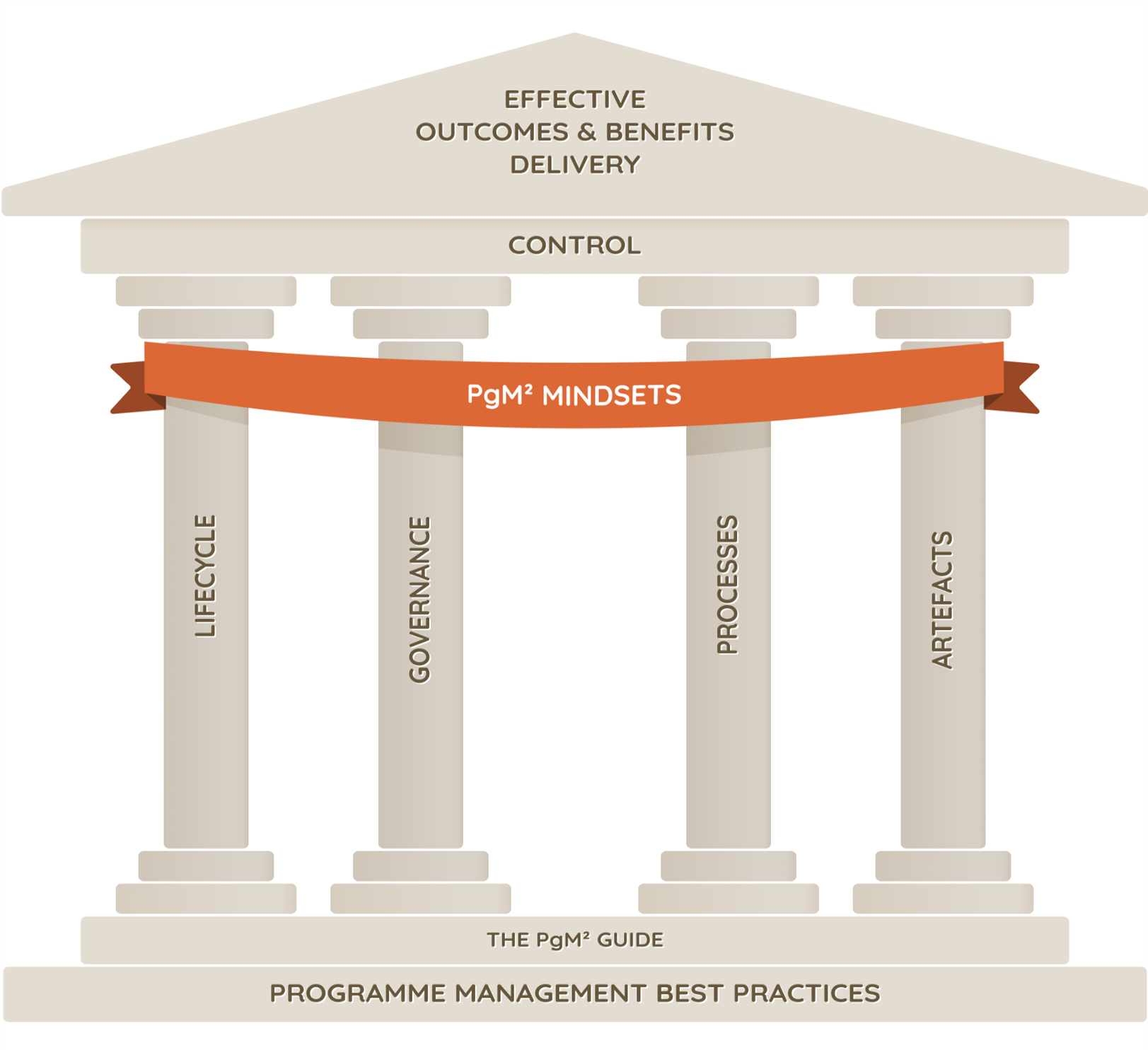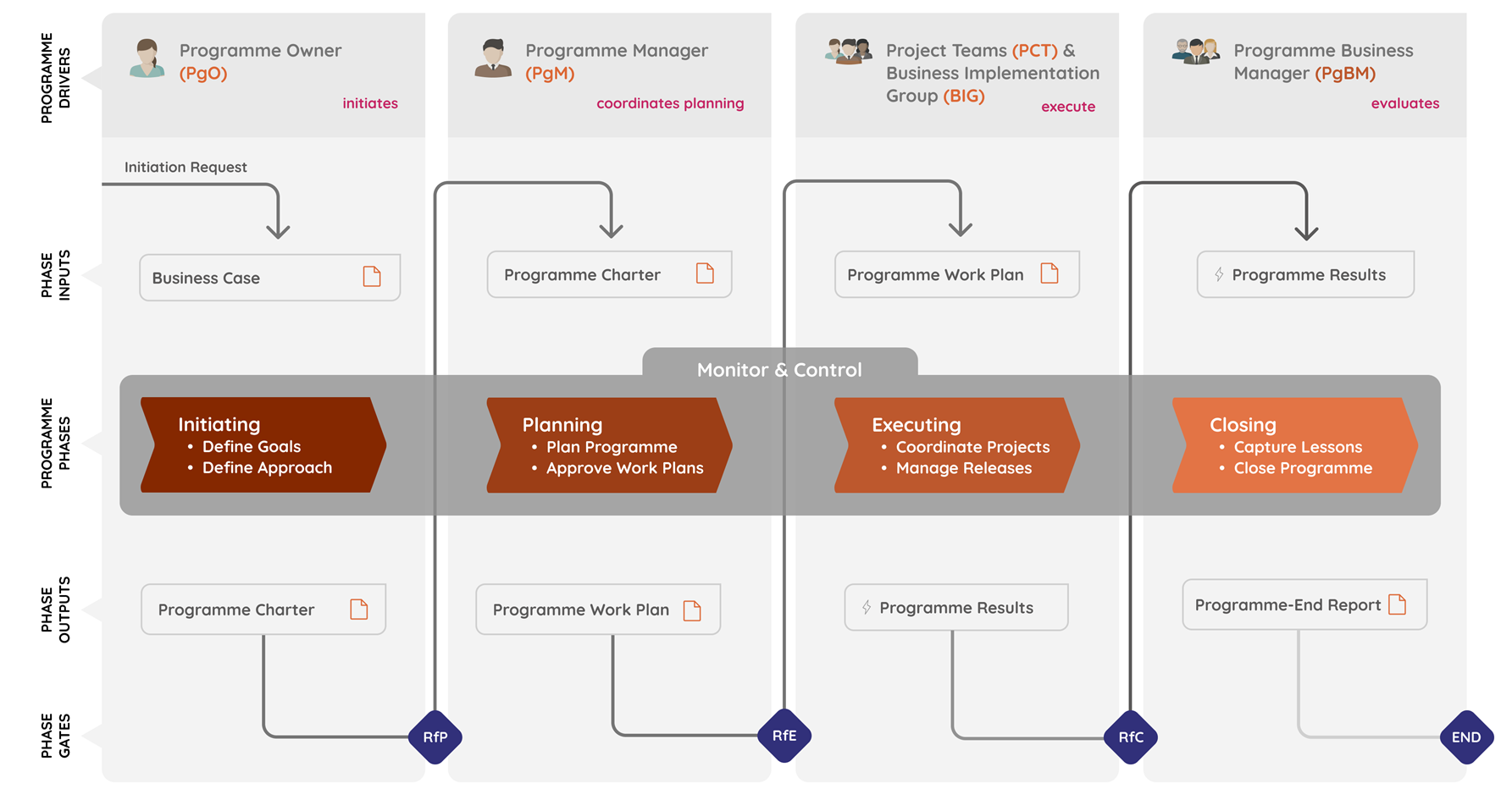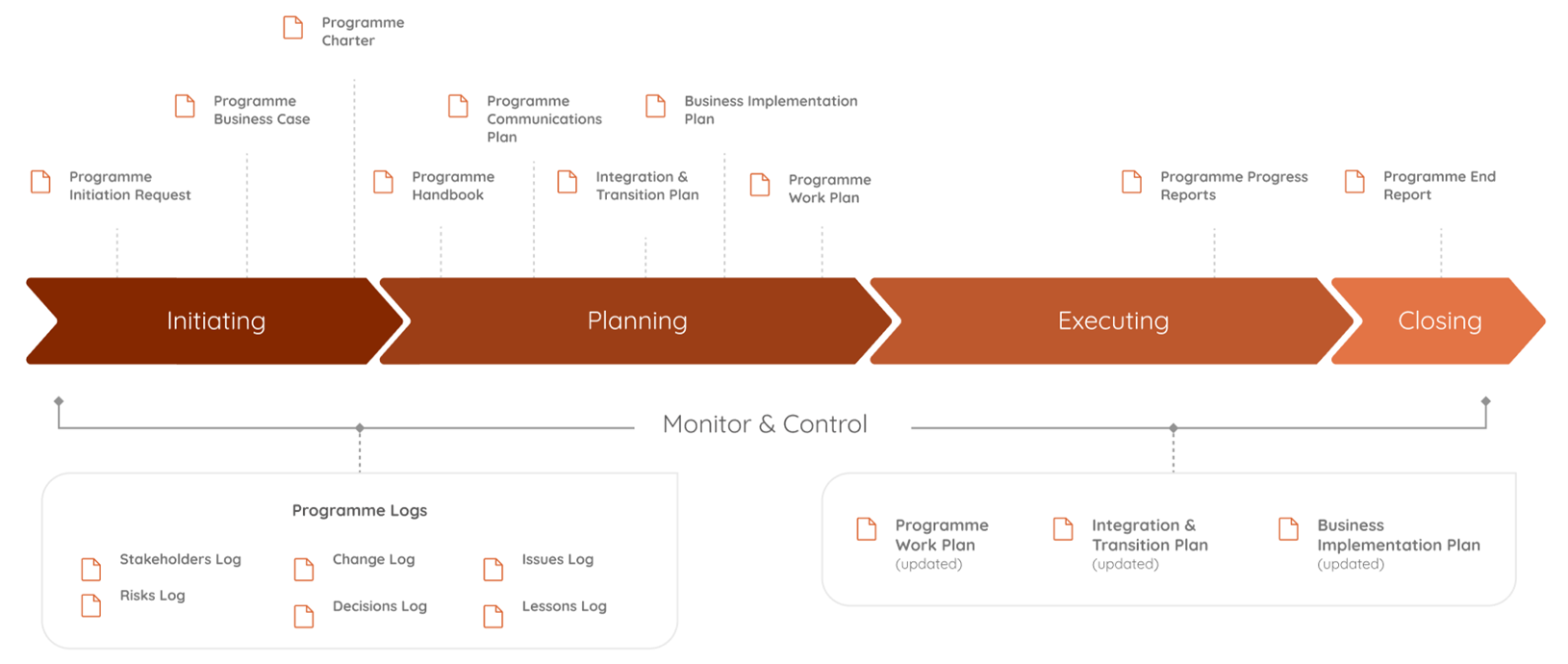PgM² presents an effective standalone programme management methodology. PgM² encapsulates globally accepted best practices from other methods and standards from PMI, AXELOS, IPMA, and the European Commission, as well as the contributions of a large number of experts, practitioners, and the broader open community over many years. The aim is to provide programme management guidelines that are lean, user-centric and that effectively communicate the PgM² Model to a broad and varied audience.
The PgM² Portfolio Management Methodology was developed to help Projectized, Functional and Matrix Organisations establish a management framework for the effective management of their programmes.
The PgM² methodology provides answers to the following fundamental questions:
- What programme management activities need to be performed to manage the programme? What are the desired outcomes of each management activity or artefact produced?
- When do the programme management activities need to be executed or management artefacts produced? How often (for recurrent activities)?
- Who is responsible for each management activity or artefact? What is the distribution of responsibilities among the programme team?
- How will each activity and artefact be implemented? What are the skills required? What are the tools, techniques or technologies that will be used?
- Why do we need a methodology? Why should we be executing a specific programme management activity? Why should we be producing the recommended programme artefact? Why is an activity or artefact needed in a specific phase or with the recommended frequency?
PgM² is supported by four pillars:
- a programme governance model (i.e. Roles & Responsibilities).
- a programme management lifecycle (i.e. the Programme Phases).
- a set of activities (i.e. programme management activities).
- a set of project Artefacts (i.e. documentation templates and guidelines).
The spirit of PgM² is further defined by the PgM² Mindsets, which provide a common set of beliefs and values for PgM² programme teams.

The PgM² Programme Management Governance
Programme governance is the framework within which programme management decisions are made. It defines all programme roles and their associated responsibilities. The programme management Roles are essentially defined by the management responsibilities assigned to them, whereas responsibilities describe what each role needs to be concerned with, their domain of (management) work and level of authority.
The Programme Steering Committee (PgSC) The Programme Steering Committee (PgSC) comprises the Programme Owner (PgO), Programme Business Manager (PgBM), and Programme Manager (PgM). Other expert roles can participate as needed.
The Programme Owner (PgO) is accountable for the programme’s success, whereas the day-to-day management of the programme is delegated to the Programme Manager (PgM), whose focus is to achieve the programme outcomes.
The Programme Business Manager (PgBM) represents the Programme Owner (PgO) on a daily basis within the programme and collaborates closely with the Programme Manager (PgM). The focus of this role is to realise the programme benefits, enabled by the programme outcomes.
Programme Business Implementation Group (BIG) assists the Programme Business Manager in Business Implementation.
A programme can also have a temporary Programme Support Team (PgST) to provide administrative assistance to the programme and its component projects.
The PgM² Responsibilities Assignment Matrix (RAM) below presents the assignment of the responsibilities for several Programme Management activities or artefacts to the various PgM² governance roles using the D-ARSCI Model (Decides, Accountable, Responsible, Supports, Consulted, Informed).
The PgM² Lifecycle
All programmes have a beginning, a middle, and an end. Since programmes can last for a long time, it is useful to divide their overall timespan into smaller periods called Phases. This division is done based on the common characteristics of the management activities executed during that period. In other words, the PgM² Phases group related programme management activities together and help the programme to focus on the phase activities and their objectives.
PgM² provides a simple and effective Lifecycle that organises programme management activities into four sequential and non-overlapping Phases (Initiating, Planning, Executing, Closing) and into one overarching process (Monitor & Control). Note that even though the names of the aforementioned PgM² Phases are identical to the PM² Phases, the programme management lifecycle is distinct from the project management lifecycle.

Programme Stages
In addition to the Phases, PgM² also accommodates the additional division of the programme lifecycle into smaller periods of time called Stages. The number and length of these stages depends both on the duration of the programme and on the incremental release plan for project deliverables— particularly as these relate to the staged achievement of programme outcomes during the Executing Phase.
During the lifecycle of the programme, a level of additional stage-planning can take place to refine the goals of the upcoming Stages and plan in more detail the transition and business implementation activities that have been defined during the Planning Phase. At the end of each Stage, a Stage Review can be organised to review the performance and results of the Stage, and to capture lessons learned that can help achieve the goal of continual improvement.
The programme Stages can be of variable lengths or of a fixed length, in which case the staged release and reporting of programme results can match the quarterly, semestrial and annual reporting periods typically used by organisations.
The programme Stages can also group to the business implementation activities which have been planned for the programme in order to establish the outcomes and intended benefits of the programme.
Programme Phase Gates
During each of the PgM² Phases, specific programme management objectives need to be achieved. The programme can then be allowed to move forward to the next Phase, based on the degree to which they have been achieved. Therefore, at the end of each phase, the programme passes through a review and approval gate. Phase Gates allow the programme to proceed in a more controlled way by providing quality control points that contribute to the overall programme management quality. This ensures that the programme is appropriately reviewed before it moves on to the next phase, with an assessment of whether the activities, outputs and objectives set for that Phase have indeed been achieved.
PgM² Artefacts
Documentation in programmes is an essential enabler for the effective initiating, planning, executing, monitoring & controlling, and closing of a programme. The purpose of programme documentation is to:
- Provide all stakeholders with a clear picture of the programme’s goals and status.
- Facilitate communication with internal and external groups.
- Provide a baseline for monitoring and controlling a programme’s progress.
- Document important decisions made.
- Provide the information required by audits (e.g. quality audits).
- Serve as a historical reference that can be used as input for future programmes.
Note that programme documentation should adhere to the organisation’s quality standards regarding format and style. Above all, however, the documentation should fulfil its purpose and be reader-friendly.
Therefore, determining what documentation is required is an important decision. The complexity and risk of the programme, as well as the expectations of the Programme Steering Committee (PgSC), will influence this decision.

PgM² Mindsets
Each of the four pillars of PgM² encapsulates a set of best practices that help programme teams manage the tangible dimensions of programmes better. On the other hand, as the fifth element of the methodology, the PgM² Mindsets become the glue that holds the PgM² pillars together. They provide a common set of beliefs and values for all PgM² practitioners.